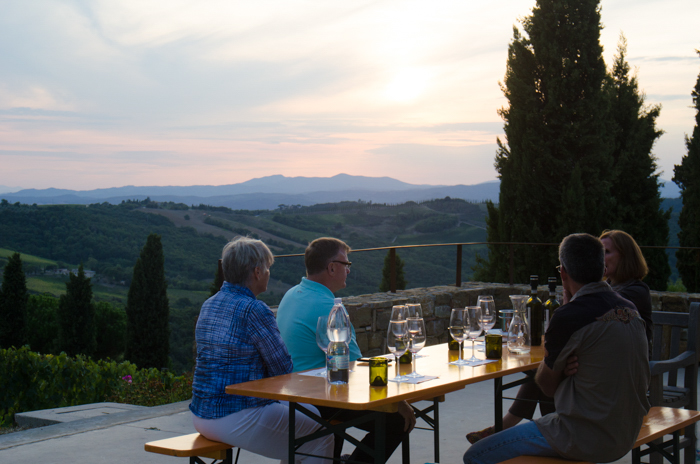
Our final – and often most loved – winery tour and tasting on our walking and cycling tours in Tuscany is Il Palazzone, a producer just outside Montalcino. Not only do we taste amazing Brunello and other wines, but our hosts are some of the most passionate and knowledgeable in the area. Laura Gray, the estate manager, oversees the day to day operation of the winery, but always has time to make our small groups welcome. Esther Mercedes Jürgens of Vino Vistas often leads our evening tours, educating us on the history of Brunello and the work that goes on behind the scenes to produce wines of this quality. I learn something new every visit.
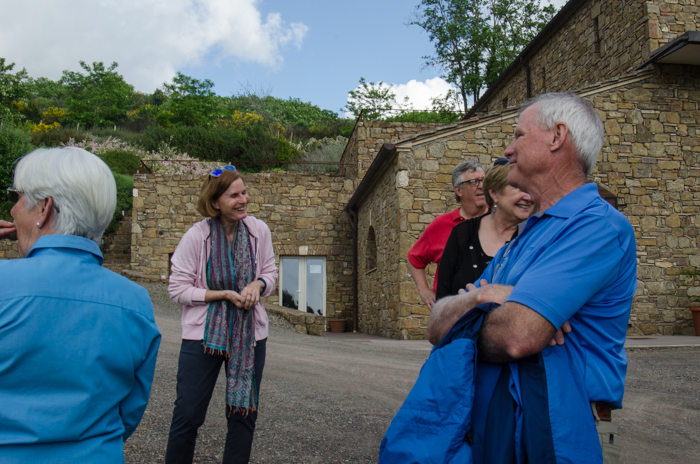
As Esther described during our last visit, Il Palazzone represents what is a ‘typical’ Brunello producer:
- small
- family owned
- foreign owned (foreign = not from Montalcino)
- wasn’t originally a winery
- multiple vineyards
My recent article on the History of Brunello will supply the background to anyone who wishes to understand why most producers follow this profile. This article here is all about why Il Palazzone is anything but ‘typical’.
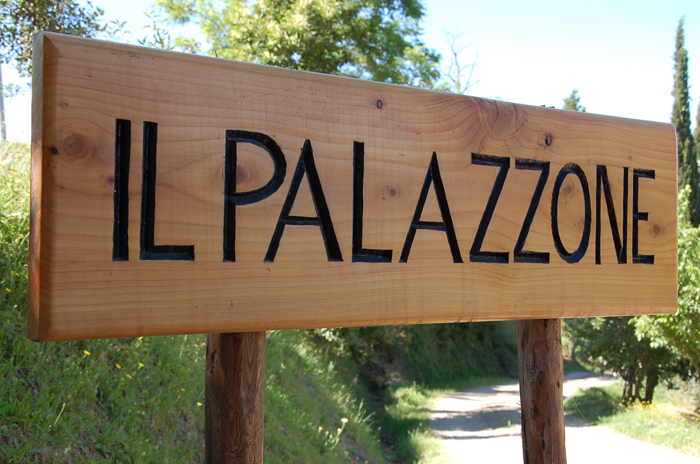
In the mid-1990s, New Yorker Richard Parsons, a frequent visitor to the area, began his search for just the right property to make his beloved Brunello. In 2000, he purchased Il Palazzone. Parsons visits frequently, participating in all the key activities of production, from hand harvesting to blending. In 2003 Laura, a trained sommelier, joined him, recruited from Parsons’ favorite local restaurant. Today, their Brunello wines are regularly rated over 90 points by Wine Enthusiast, Wine Spectator and other well-regarded wine reviewers.
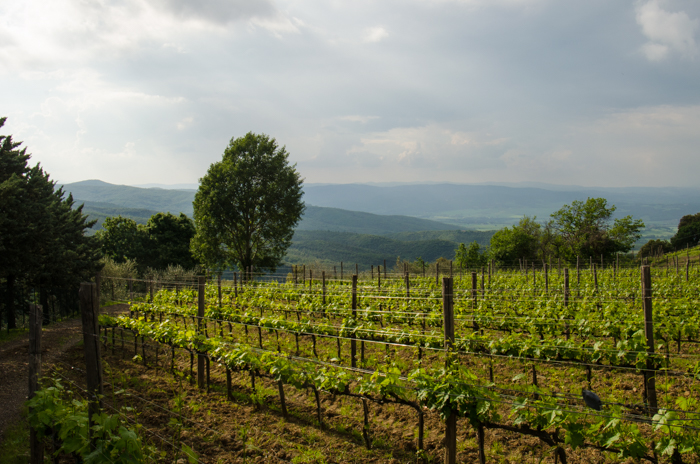
We begin every tour at the source – the vineyard. Currently, Il Palazzone has three separate vineyards in different areas of Montalcino. In spite of its small size, this wine zone boasts a broad variety of terroirs (see my article on the Terroir of Brunello), very important for a grape such as Sangiovese which is extremely dependent on its growing environment. Having three vineyards in three different locations allows the winemakers of Il Palazzone to create blends using grapes from three locations, adjusting each year to best reflect the results of each harvest.
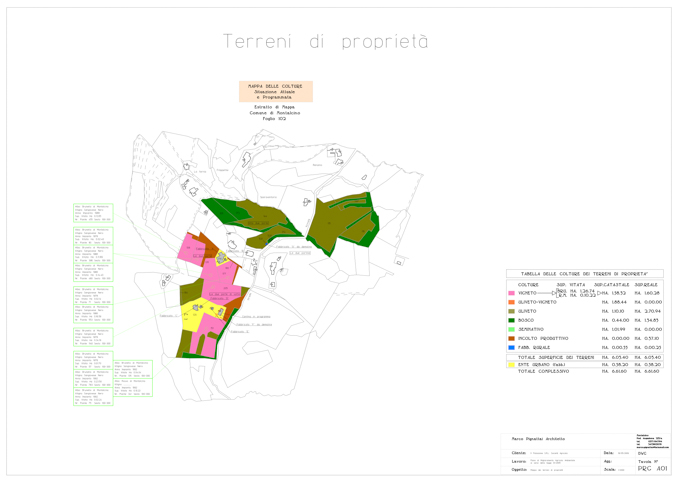 The vineyard we visit is their Due Porte vineyard, just outside of Montalcino to the northwest. This is their highest vineyard, at 1700 feet. The elevation and northwest exposure result in later ripening, but excellent ventilation and large diurnal temperature variation results in grapes that are high in fruit and maintain good acidity even in hotter years, necessary for long aging.
The vineyard we visit is their Due Porte vineyard, just outside of Montalcino to the northwest. This is their highest vineyard, at 1700 feet. The elevation and northwest exposure result in later ripening, but excellent ventilation and large diurnal temperature variation results in grapes that are high in fruit and maintain good acidity even in hotter years, necessary for long aging.
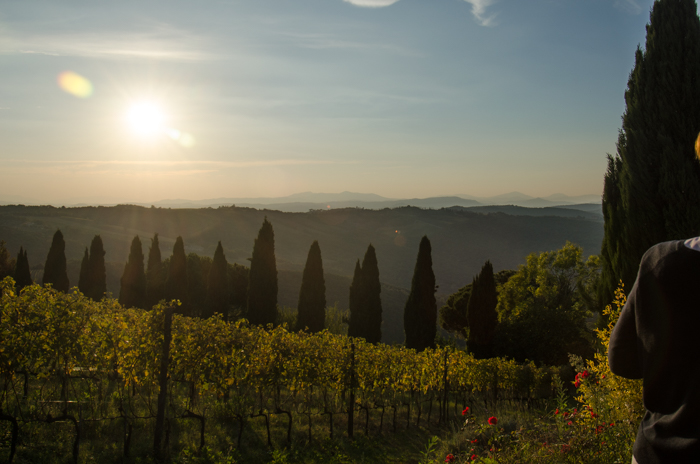
The other two vineyards are located in the southeast corner of the Brunello zone, near Castelnuovo dell’Abate. The Vigna del Capa vineyard is over 700 feet lower in elevation, with a southern exposure. The area here, at lower elevation, emerged much later from the sea that covered this land millions of years ago. The terroir here is noticeably more saline, with minerals such as iron, magnesium and manganese in the soil. The grapes from these vineyard have an incredible minerality, ripen sooner, with more sugars.
Esther leads us over to the vines, and explains Il Palazzone’s commitment to “responsible agriculture”. While not officially certified organic, they do not use any chemical pesticides or insecticides. The few treatments used are allowed in organic farming. As an example, after a violent hail storm this spring damaged the young vines, they were treated with an algea to assist with recovery.
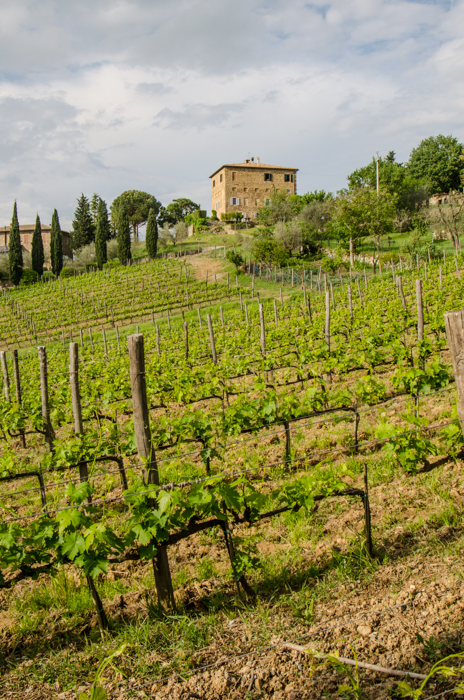
We learn about their use of cover crops, which I’ve seen employed by other quality producers with a commitment to sustainability. Cover crops are nitrogen rich legumes such as lupins, fava beans and clover which are planted in alternate rows. These are then ploughed under, enriching and fertilizing the soil. This reduces erosion, improves water absorption and increases organic matter which enhances soil structure and eliminates the need for chemical fertilizers. Cover crops also increase biodiversity, as evidenced by the flowers, butterflies, ladybirds and earthworms in the vineyard.
Cultivating the vines is very hands-on, from beginning to end. From careful pruning, to stripping away individual vine-leaves in order to allow bunches to dry after rain in order to prevent grey mold rather than resorting to use of anti-fungal sprays, painstaking manual labor pays off in the end. Robert Parsons invites a crew of friends to be part of the harvest, putting passionate oenophiles to work in the fields. Many return year after year.
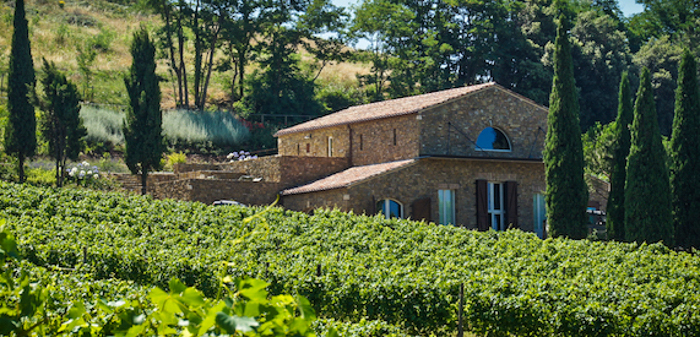
After our tour of the vineyards, we enter the cellar. Built in 2012, the cellar was designed by local architect Marco Pignattai to blend in with the historical architecture of the area. The cellar looks like a church nestled among the vineyards, belying the modern production facility housed inside. We enter the vinification room, built with a gabled roof style used throughout the Val d’Orcia. Green initiatives that were incorporated into this traditional design include recovering rainwater for irrigating the surrounding gardens (irrigation of the vines themselves is only allowed in emergency situations) and cellar work, installing an air exchange system to maintain temperature throughout the seasons and reduce energy use, using 90% recycled bricks for the roof and the walls, and sourcing all the stone for the landscaping from an on-site quarry.
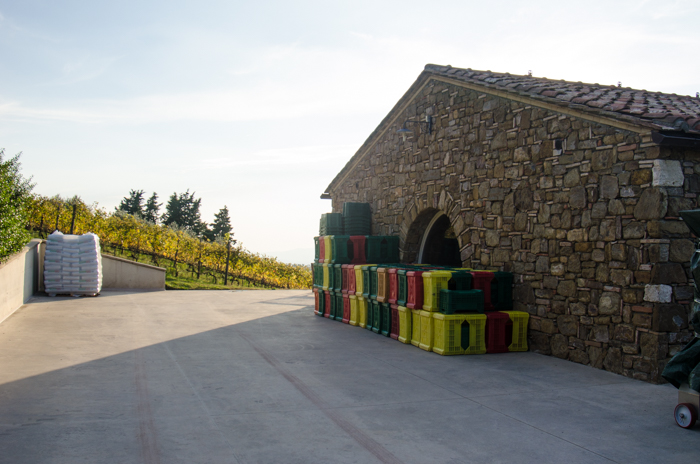
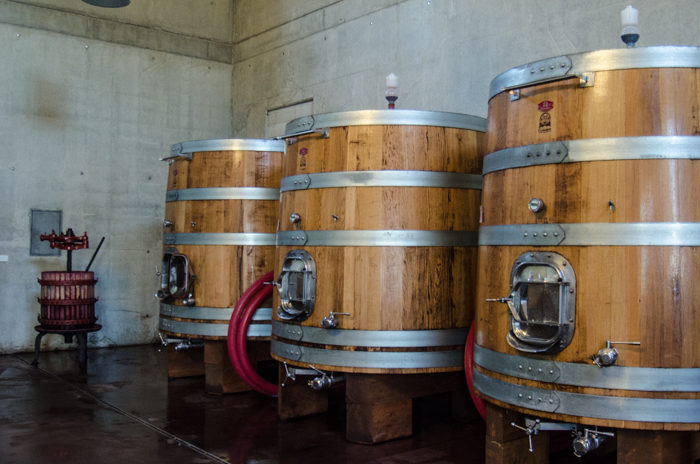
The vinification room holds the fermentation barrels and the traditional press that is used to press the grapes. This room is quite quiet for most of the year, but in mid October, just a few weeks after harvest, it is full of the almost palpable aromas of fermentation as the yeasts go to work, converting the sugars stored in the grapes during the growing season into alcohol and carbon dioxide. We take a few minutes here to soak in the atmosphere and review the fermentation process. Fermentation takes place in beautiful wooden 5000 liter barrels. The tannins in the oak are an anti-oxidant. This, combined with the micro-oxygenation permitted by the wood, results in a clean wine with increased aromatic and tannin stability.
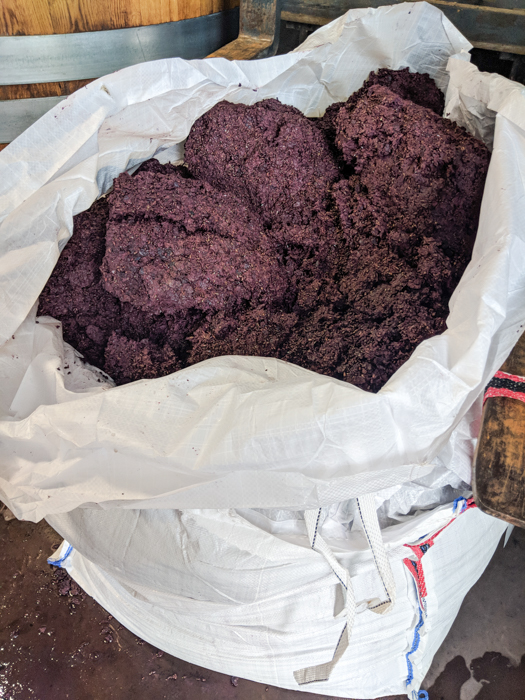
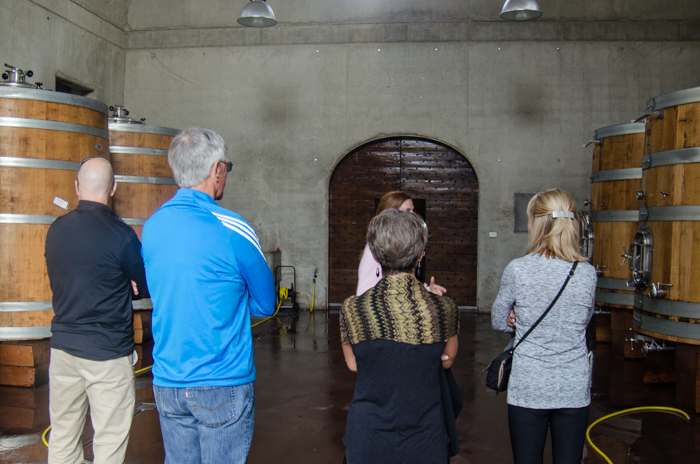
We wander next to the aging room, moving from a large, open, warehouse type room to a peaceful, dark, quiet space – an appropriate environment for a wine to rest and gracefully develop. Above us, an undulating roof made of thousands of small cedar slats, reminiscent of the waves in the ancient ocean that gave birth to this terroir.
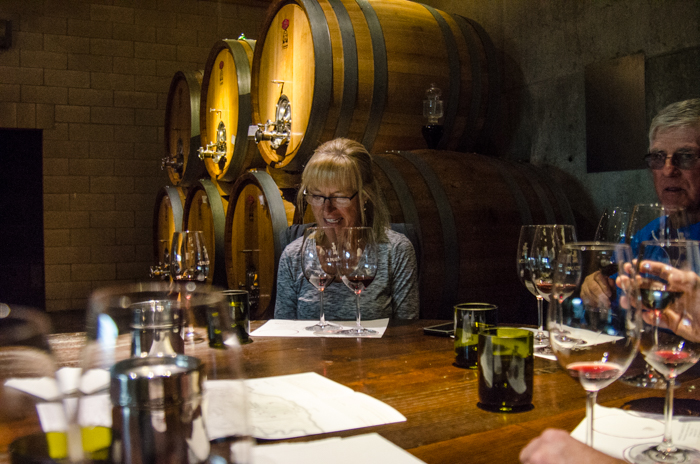
A simple, but elegant tasting is already arranged for us in the center. We are surrounded by the large Slavonian oak “botti” that Il Palazzone prefers for aging. Botti can vary in size, from 1500 to 10000 liters, and perform the so-called “traditional” style of aging. This is in contrast to “modern” style aging which employs smaller 225 liter French oak barriques. The decision to use botti today is an important one, as the cellar must allow ample room – barriques can be packed more efficiently on racks – as well as a large entry for installation. It is not the most cost-effective option. The thick walls, fine-grained Slavonian oak, and less surface area to contact the wine require a longer aeration time, but results in increased complexity, more fruit, and ultimately a wine with more aging potential. Il Palazzone Brunello often spends nearly four years in wood. Current DOCG regulations specify a minimum of only two years. In exceptional vintages the best grapes are devoted to their prestigious Riserva. An Il Palazzone Riserva spends a year more in wood than the vintage Brunello and is released a year afterwards.
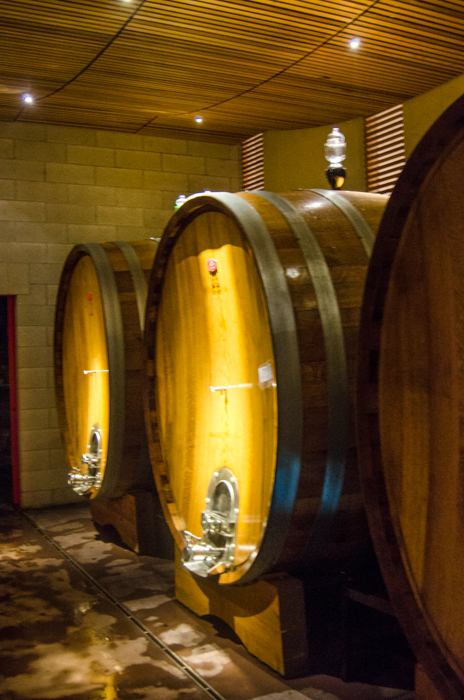
We taste first the Rosso del Palazzone. As mentioned earlier, the three Brunello vineyards are in three very different areas of Montalcino. Consequently each vineyard ripens at a different time and the picked grapes show very different qualities due to difference in soil, age of vines, position and altitude. The ensuing wines are also vinified separately. The team at Il Palazzone creates the ideal composition for each vintage of Brunello by combining the three 100% Sangiovese vineyards in different proportions, depending on whether or not they produce a Riserva and the fluctuations of the growing season.
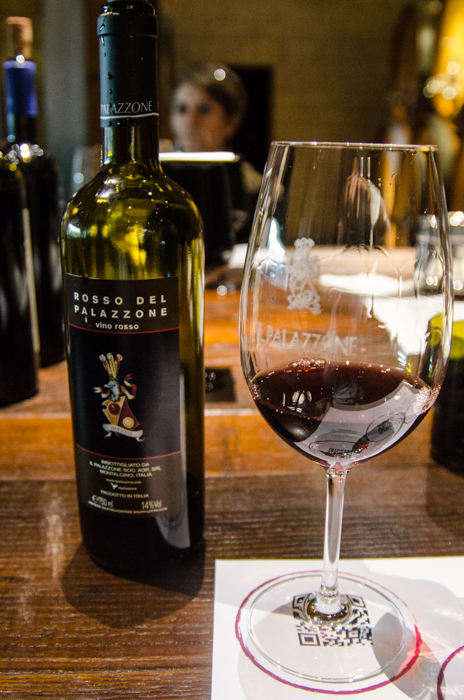
Occasionally they choose not to include a barrel of wine from one vineyard or the other in order to maintain a perfect balance in their Brunello. This wine, potential Brunello, is set aside to make their Rosso del Palazzone. During my last visit, we sampled the NV 01/18 Rosso del Palazzone, a 100% Sangiovese Grosso blend of 80% 2016 and 20% 2017 vintages. Deep red in color, with typical flavors of fresh cherry, complemented by herbal notes and a nice minerality. This versatile wine pairs well with a variety of foods, including soups, pastas, grilled meats and cheeses.
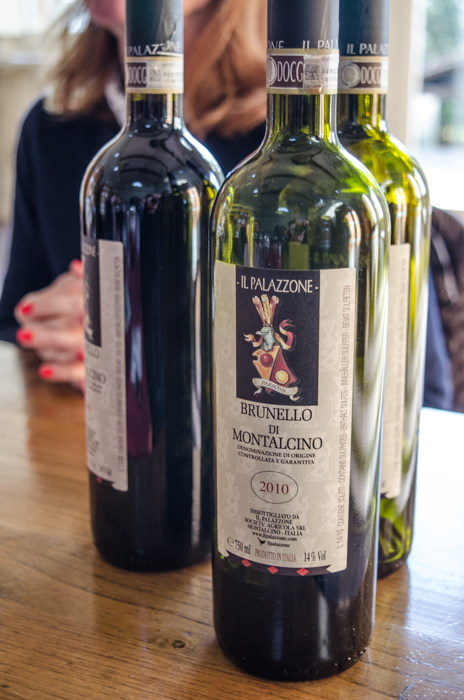
We then sampled two amazing Il Palazzone Brunello, this visit their 2009 and 2013 Brunello di Montalcino. Il Palazzone Brunello di Montalcino DOCG is produced with 100% Sangiovese Grosso grapes. Il Palazzone follows the traditional aging requirements for Brunello, a minimum four years, at least two of which must be in oak.
2009 was a very hot summer, resulting in a warm and rich wine. Il Palazzone decided to balance the effects of the heat with considerably less wood aging than normal: only 34 months compared to their typical 40 plus months. Too much time in wood for a ripe vintage like this would risk exhausting the wine and reducing its aging potential. This wine possesses aromas of fresh cherry, damp earth, and tobacco. Elegant, but subtle, well-balanced. Great with braised meat dishes and game.
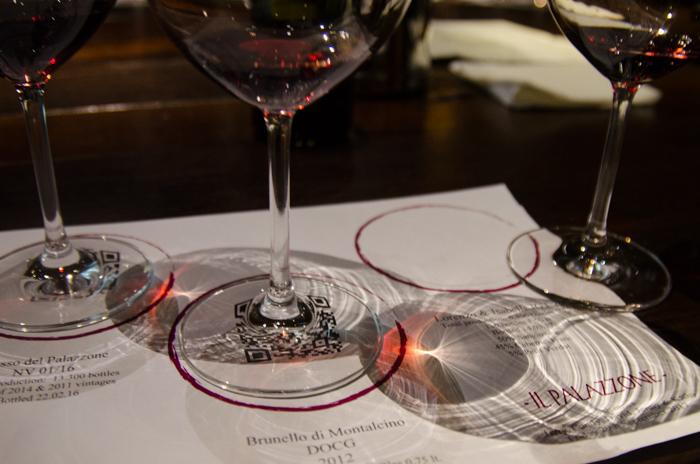
The 2013 is the most recent vintage, so it has not yet come in to its own, but shows great promise. After hot and torrid 2011 and 2012, the cool, wet and extended spring of 2013 was welcomed. September brought an extended series of warm ventilated days and cool nights, perfect for increasing aromatics, keeping acidity high and alcohol in check. This was given 38 months of aging in the wood botti. The color is a deep ruby with garnet hues. Many aromas develop, from cherry fruit to vanilla to anise and leather. A fresh acidity with a well-rounded structure from start to finish. Pair with a nice beef stew or goulash.
After enjoying a final taste of Il Palazzone Grappa that Esther insisted we try (I never turn down a taste of grappa), we exit the cellar to meet our transfer back to Montalcino. A spectacular moonrise provides the perfect ending to delightful evening. Off to enjoy some more Brunello with our farewell feast in Montalcino – we couldn’t resist finishing with a bottle of 2012 Il Palazzone Brunello!
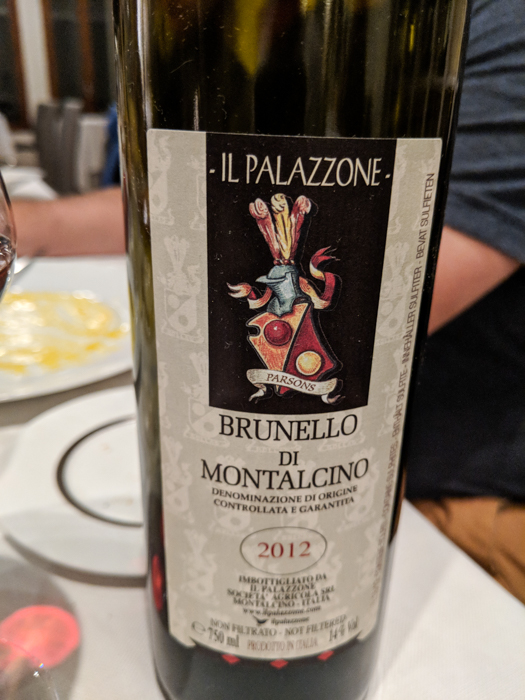


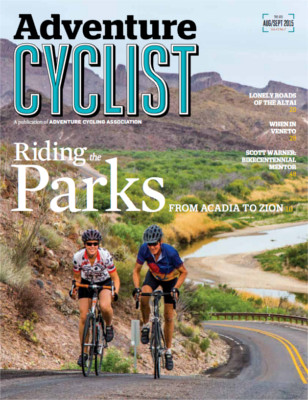


2 Responses to Walk and Wine in Tuscany – Il Palazzone